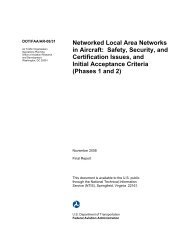Published Report (DOT/FAA/CT-94-36)
Published Report (DOT/FAA/CT-94-36)
Published Report (DOT/FAA/CT-94-36)
Create successful ePaper yourself
Turn your PDF publications into a flip-book with our unique Google optimized e-Paper software.
isk blunders, but only 2 TCV's. The actual TCV rate was only<br />
0.011. The 0.99 confidence interval indicated the TCV rate could<br />
be as high as 0.049 or 5 TCV's per 102 worst case blunders.<br />
Using the estimate of 1 worst case blunder per 100 30° blunders,<br />
the acceptable blunder rate for the FMA simulation becomes:<br />
130" Blunder<br />
1,021 triple app<br />
If it is assumed that the ratio of worst case blunders to 30'<br />
blunders is 1/10, then the acceptable blunder rate for the FMA<br />
becomes :<br />
130" Blunder<br />
10,210 triple app<br />
In either case, the acceptable rate for the FMA is about 13.5<br />
times larger than the acceptable rate for the FDADS, thus<br />
indicating that the use of the FMA will result in an operation<br />
with less risk than the FDADS.

















